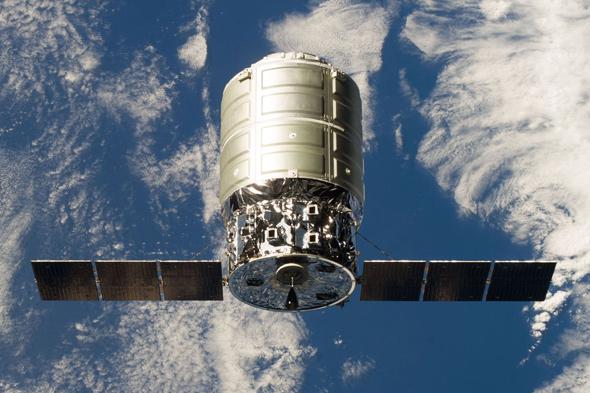Update, Dec. 6, 2015 at 22:00 UTC: Success! The Atlas rocket with the Cygnus spacecraft on top lifted off from Florida right on time at 21:44 UTC. Cygnus separated from the Centaur upper stage and has begun its slow climb to match orbits with the International Space Station in a few days.
Update 3, Dec. 5, 2015 at 20:00 UTC: Today’s launch attempt has already been canceled due to high winds at the launch site. The next attempt will be tomorrow, Sunday, Dec. 6 with a launch window opening at 21:44 UTC (4:44 p.m. Eastern US time).
Update 2, Dec. 4, 2015 at 23:00 UTC: After several attempts during the launch window, the launch was scrubbed again due to ground winds being too strong. The next attempt will be tomorrow, Saturday, Dec. 5, with a 30 minute window opening at 22:10 UTC (5:10 p.m. Eastern US time).
Update, Dec. 3, 2015 at 23:20 UTC: Well, drat. Weather prevented the launch of the Atlas/Cygnus today. The next launch window opens Friday, Dec. 4, at 22:33 UTC (5:33 p.m. Eastern US time), but the weather forecast looks pretty rotten for then, too. Stay Tuned.
A resupply mission is scheduled to head for the International Space Station Thursday night: The Orbital ATK company’s Cygnus spacecraft, named SS Deke Slayton II, should launch at 22:55 UTC (5:55 p.m. Eastern US time) Thursday. Slayton is carrying more than 3 tons of equipment and supplies for the astronauts on ISS. The spacecraft is uncrewed.
You can watch this launch live on NASA TV or on the NASA UStream channel (I usually use the latter).
This is the fifth Cygnus spacecraft in the series. Sort of. The first three were successfully launched on the Orbital’s Antares rocket,* but the fourth, the original Deke Slayton, suffered a catastrophic failure when the (uncrewed) rocket exploded. It still isn’t clear what went wrong, though most people assume it had to do with the old, refurbished Russian-built engines the Antares used.
The Antares rockets are currently undergoing a redesign, including using a different rocket engine. In the meantime, Orbital has a contractual obligation to NASA to supply ISS, so this mission is going up on the United Launch Alliance’s extremely dependable Atlas V. The Cygnus has been upgraded as well, with more capacity, new solar panels, and new fuel tanks.
If the launch goes as scheduled, Slayton should arrive at ISS on Sunday and will stay berthed for about a month. During that time the supplies will be offloaded (to use NASA jargon), and it’ll be loaded up with more than a ton of trash. Once it deberths, it’ll drop back down into our atmosphere and burn up. Previous Cygnus missions have provided dramatic footage of those events, so hopefully we’ll get more of the same this time, too.
* The first flight was a demo, to show it could be done. The next flight was then the first of the missions in the NASA Commercial Resupply Service contract. So this is the fifth Cygnus, but the fourth in the series under the CRS contract.
